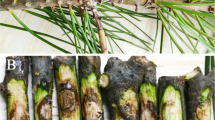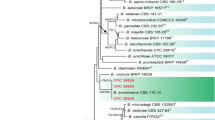Abstract
Botrytis leaf blight is the most important disease of Chinese chives. We examined a total of 345 isolates from symptomatic plants sampled from 14 fields in Hokkaido once in 2010 (summer) and twice in 2011 and 2012 (summer and autumn). They were identified as Botrytis squamosa (BS: 285 isolates) and B. cinerea (BC: 60 isolates) based on conidial morphology. Morphological identification of 65 BS isolates and 23 BC isolates supported by PCR–RFLP analysis and specific PCR. BS isolates were much more frequently obtained than BC isolates in autumn, but in summer, both species were almost equally recovered. BS predominated in all the fields in the autumn of the 3 years although the ratio of BS to BC in summer varied, depending on the field and year. These results indicate that both species infect leaves in summer, then BS becomes dominant in autumn. Inoculation tests revealed that BS was more virulent than BC at 15 and 20 °C and that the level of virulence of both species was greatly reduced at 20 °C. These results may account for fluctuations in the occurrence of the pathogens.





Similar content being viewed by others
References
Agrios GN (2005) Botrytis diseases. In: Plant pathology (5th ed) Elsevier Academic Press, San Diego, pp 510–514
Beever RE, Weeds PL (2007) Taxonomy and genetic variation of Botrytis and Botryotinia. In: Elad Y, Williamson B, Tudzynski P, Delen N (eds) Botrytis: biology, pathology and control. Springer, Dordrecht, pp 29–52
Carisse O, Tremblay DM, McDonald MR, Brodeur L, McRoberts N (2011) Management of Botrytis leaf blight of onion: the Québec experience of 20 years of continual improvement. Plant Dis 95:504–514
Crowe F, Mohan SK, Schwartz HF (1995) Other Botrytis disease. In: Schwartz HF, Mohan SK (eds) Compendium of onion and garlic diseases. APS Press, St. Paul, pp 19–20
Ellis MB (1971) Dematiaceous hyphomycetes. CAB Publishing, Wallingford, pp 178–184
Hennebert GL (1963) Les Botrytis des Allium. Meded Landbouwhogesch Opzoekingsstn Staat Gent 28:851–876
Jarvis WR (1980) Taxonomy. In: Coley-Smith JR, Verhoeff K, Jarvis WR (eds) The biology of Botrytis. Academic Press, London, pp 1–18
Kannno H, Sakurai K, Horiuchi S (2000) Epidemiology and control of Botrytis leaf blight of Chinese chive (Abstract in Japanese). Ann Rept Plant Prot North Jpn 51:295
Kawagishi K, Abe T, Ubukata M, Kato S (2009) Inhibition of flower stalk elongation and abnormal flower development by short-day treatment in a Japanese variety of Chinese chive (Allium tuberosum Rottler ex Sprengel). Sci Hortic 119:197–202
Lacy ML, Lorbeer JW (1995) Botrytis leaf blight and Botrytis neck rot. In: Schwartz HF, Mohan SK (eds) Compendium of onion and garlic diseases. APS Press, St. Paul, pp 16–19
Lorbeer JW, Seyb AM, de Boer M, van den Ende JE (2007) Botrytis species on bulb crops. In: Elad Y, Williamson B, Tudzynski P, Delen N (eds) Botrytis: biology, pathology and control. Springer, Dordrecht, pp 273–294
Misawa T (2010) Control effectiveness of foliar application of several chemical and biological control agents against leaf blight of Chinese chive caused by Botrytis squamosa and its duration (in Japanese with English summary). Ann Rept Plant Prot North Jpn 61:85–89
Misawa T (2014) Botrytis squamosa, the causal agent of Chinese chive leaf blight, overwinters in the form of sclerotia produced on diseased leaves (Abstract in Japanese). Jpn J Phytopathol 80:58
Nieda H, Takahashi T, Hoshino F (1971) Control of white spot symptom of Chinese chive (in Japanese). Annu Rept Kanto-Tosan Plant Prot Soc 18:49–50
Nielsen K, Justesen AF, Jensen DF, Yohalem DS (2001) Universally primed polymerase chain reaction alleles and internal transcribed spacer restriction fragment length polymorphisms distinguish two subgroups in Botrytis aclada distinct from B. byssoidea. Phytopathology 91:527–533
Nielsen K, Yohalem DS, Jensen DF (2002) PCR detection and RFLP differentiation of Botrytis species associated with neck rot of onion. Plant Dis 86:682–686
Rigotti S, Viret O, Gindro K (2006) Two new primers highly specific for the detection of Botrytis cinerea Pers.: Fr. Phytopathol Mediterr 45:253–260
Shoemaker PB, Lorbeer JW (1977) Timing initial fungicide application to control Botrytis leaf blight epidemics on onions. Phytopathology 67:409–414
Staats M, van Baarlen P, van Kan JAL (2005) Molecular phylogeny of the plant pathogenic genus Botrytis and the evolution of host specificity. Mol Biol Evol 22:333–346
Takakuwa M, Saito I, Tanii A, Tamura O (1974) Leaf spots on onions and leeks caused by Botrytis spp. (in Japanese with English summary). Bull Hokkaido Pref Agric Exp Stn 29:1–6
Zhang J, Zhang L, Li GQ, Yang L, Jiang DH, Zhuang WY, Huang HC (2010) Botrytis sinoallii: a new species of the grey mould pathogen on Allium crops in China. Mycoscience 51:421–431
Acknowledgments
We thank farmers in Shiriuchi for permission to conduct this study on their farms. For help with this work, we also thank T. Yamaguchi, M. Ohira and M. Matsuzawa (Hokkaido Prefectural Oshima Agricultural Extension Center, Japan). Special thanks are due to Dr. N. Matsumoto (Hokkaido University, Japan) for valuable comments and English correction of the manuscript.
Author information
Authors and Affiliations
Corresponding author
Rights and permissions
About this article
Cite this article
Misawa, T., Takeuchi, M. Species composition of Botrytis leaf blight pathogens of Chinese chives and their seasonal and annual changes in Hokkaido, Japan. J Gen Plant Pathol 81, 218–225 (2015). https://doi.org/10.1007/s10327-015-0588-9
Received:
Accepted:
Published:
Issue Date:
DOI: https://doi.org/10.1007/s10327-015-0588-9




